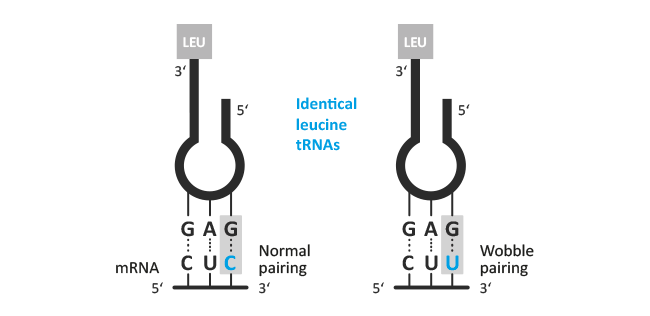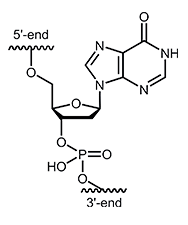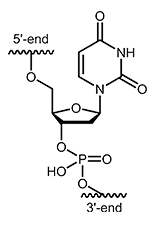
Sequence Modifications
Modifications of oligonucleotides can be very versatile. Here, in addition to terminal modifications of the 3´-or 5´-end of an oligonucleotide, also internal changes in the sequence are possible. The incorporation of certain nucleosides into the base sequence can sometimes also considerably affect the behavior of cells in the organism.
Below we present some of our sequence modifications of oligonucleotides available with us.
Wobbles
Wobbles
In molecular genetics, the wobble hypothesis explains how a particular tRNA can pair more than one mRNA triplet (codon). The first two positions of the codon usually bind to complementary bases of the anticodon of tRNA. Only the first position of the anticodon is not always specified and due to utilisation of rare bases like inosine, unusual base pairings are possible (wobble position).
Possible variants:
| Guanosine : Uridine | Inosine : Uridine | Inosine : Adenosine | Inosine : Cytidine |
 |
Oligonucleotides with wobbles (mixed bases, degenerate bases) can be used in many applications. During the synthesis of oligonucleotides wobbles can be incorporated at defined positions. Depending on the type of mixing base, specific statistical distributions of bases can be generated at each position in the oligo.
Synthesis of oligos with wobbles:
Many modern DNA/RNA synthesizer “understand” the one letter code for wobbles (see below) and are able to mix the respective building blocks in the right proportion during the synthesis (2-wobble: 50% of each component,
3-wobble: 33% each and N=4-wobble: 25%). This quick and easy method usually leads to good results with small deviations from the desired statistical distribution. Depending on the particular sequence and the difference in reactivity of the building blocks, in individual cases the deviations can be higher.
In critical cases or larger synthetic approaches manual mixing of the bases in the right proportion before the synthesis of the oligos can significantly improve the results. Furthermore, mixtures are also possible that deviate from a uniform distribution. For further information please contact our customer support team.
Purification of oligos with wobbles:
Depending on the type and number of wobbles the synthesised oligonucleotide is composed of a variety of different sequences. These, possibly several thousand sequences may differ for example in their mobility in polyacrylamide gels (PAGE) or on the HPLC column. Oligos having many wobbles in their sequence lead to a broadening of the corresponding gel band or peak in the HPLC. Especially when cutting bands out of gel there is a risk that single sequences of the wobble mix get "lost". According to this we do not recommend PAGE purification of oligonucleotides with mixed bases, or only after consultation with our technical support team.
The following internationally valid "one letter code" shows the possible wobble combinations of the four standard bases. Please use this code when ordering oligonucleotids with degenerate bases.
| Symbol | Explanation | Bases |
|---|
| Normal bases | |||||
| A | Adenine | A | |||
| C | Cytosine | C | |||
| G | Guanine | G | |||
| T | Thymine | T | |||
| U | Uracil (only RNA) | U | |||
| Wobble bases | |||||
| W | Weak (binding bases) | A | T | ||
| S | Strong (binding bases) | C | G | ||
| M | aMino | A | C | ||
| K | Keto | G | T | ||
| R | puRine | A | G | ||
| Y | pYrimidine | C | T | ||
| B | Not A (B comes after A) | C | G | T | |
| D | Not C (D comes after C) | A | G | T | |
| H | Not G (H comes after G) | A | C | T | |
| V | Not T (V comes after T and U) | A | C | G | |
| N | aNy base | A | C | G | T |
Deoxyinosine (dI)
Deoxyinosine (dI)
|
In addition to the four DNA bases, adenine, cytosine, guanine and thymine, the bases uracil and inosine and other rare nucleotides can be found in RNA. Inosine is an extremely rare nucleoside of RNA and it is composed of the sugar β-D-ribofuranose and the base hypoxanthine. |
 |
| The following table shows the possible mismatches of bases: |
|---|
| tRNA | A | C | G | U | I |
| mRNA | U | G | C | A | A |
| U | G | C | |||
| U | |||||
| G |
This wobble effect is also possible in oligonucleotides. Due to integration of an inosine nucleotide to the sequence of a primer, the primers obtain "variable" bases. These degenerate primers allow e.g. annealing and amplification of multiple related sequences. While using degenerate primers in PCR, DNA polymerases, such as Pfu, which have a so-called proof-reading function, have been reported to fall off the DNA as soon as they meet wobble bases in the sequence of the primer.3
Order information:
Please be aware to enter deoxy-inosine, as well as ribo-inosine (2´-dInosine, rI) as internal modifications in the order. Identify the position of the internal modification in your sequence by a number (5,6,7,8), which mark the corresponding pull-down menu in the online order form. If no modifications are available for selection, neither the scale “XS” nor the purification “cartridge” must be selected for ribobases.
Literature:
1. Studies on the base pairing properties of deoxyinosine by solid phase hybridisation to oligonucleotides. Case-Green SC, Southern EM; Nucleic Acids Res. (1994), 22(2):131-6.
2. Base pairing involving deoxyinosine: implications for probe design. Martin FH, Castro MM, Aboul-ela F, Tinoco I Jr.; Nucleic Acids Res. (1985), 13: 8927-8938.
3. PCR with degenerate primers containing deoxyinosine fails with Pfu DNA Polymerase. Knittel T, Picard D, PCR Methods and Applications (1993), 2: 346-347.
2´-deoxy-Uridine (dU)
Deoxyuridine (dU)
|
The nucleoside deoxyuridine (dU) consists of the sugar β-D-deoxyribose and the nucleobase uracil. |
 |

